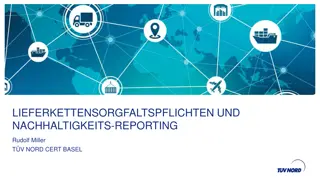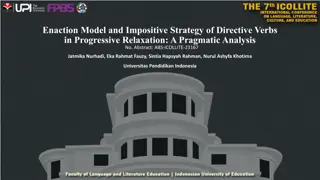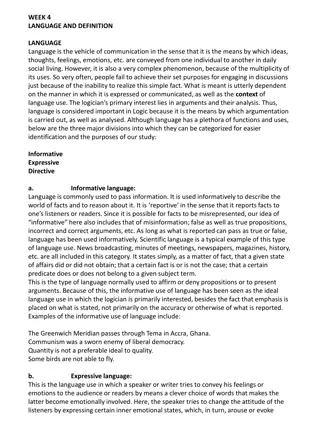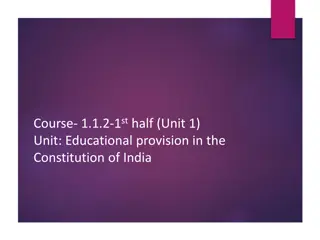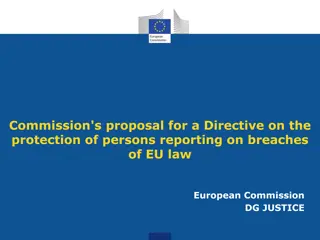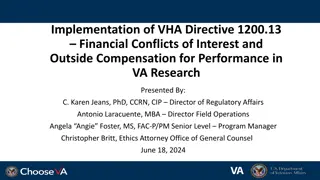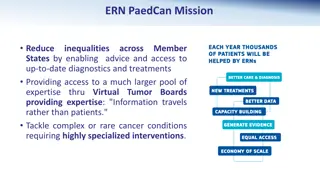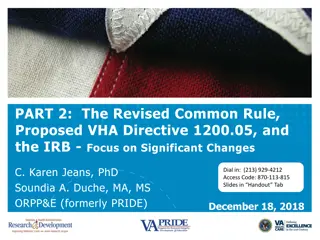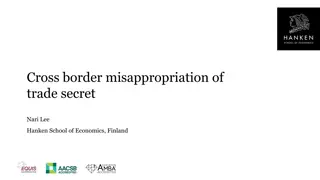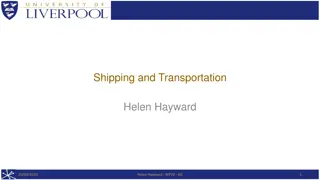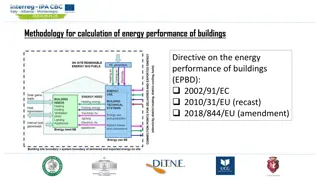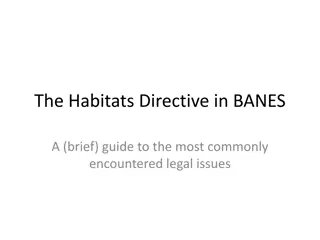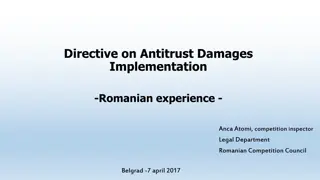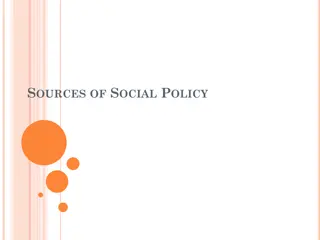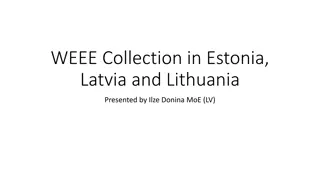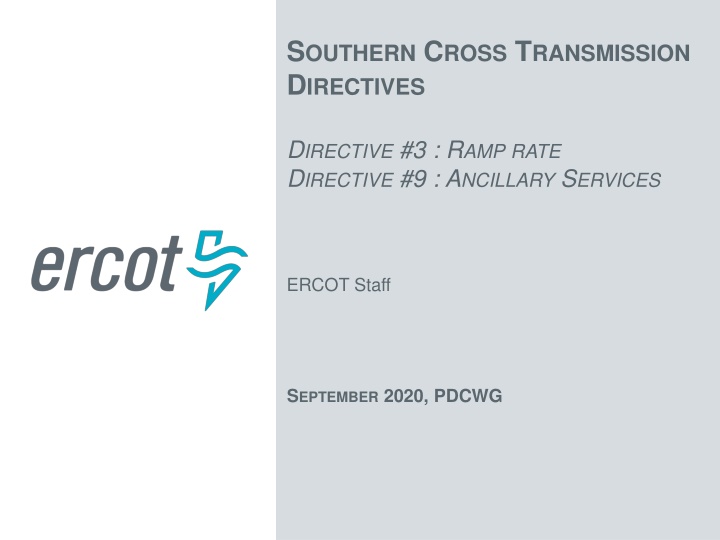
Southern Cross Transmission Directives for ERCOT
Dive into the details of Southern Cross Transmission directives #3 and #9 for ERCOT, focusing on ramp rate restrictions and ancillary services evaluation and implementation. Follow the journey from initial discussions to current progress in fulfilling these directives.
Download Presentation

Please find below an Image/Link to download the presentation.
The content on the website is provided AS IS for your information and personal use only. It may not be sold, licensed, or shared on other websites without obtaining consent from the author. If you encounter any issues during the download, it is possible that the publisher has removed the file from their server.
You are allowed to download the files provided on this website for personal or commercial use, subject to the condition that they are used lawfully. All files are the property of their respective owners.
The content on the website is provided AS IS for your information and personal use only. It may not be sold, licensed, or shared on other websites without obtaining consent from the author.
E N D
Presentation Transcript
SOUTHERN CROSS TRANSMISSION DIRECTIVES DIRECTIVE #3 : RAMP RATE DIRECTIVE #9 : ANCILLARY SERVICES ERCOT Staff SEPTEMBER 2020, PDCWG
Directive #3 ERCOT shall determine what ramp rate restrictions, if any, will be necessary to accommodate the interconnection of the Southern Cross DC tie and shall implement those restrictions and shall certify to the Commission when it has completed these actions. 1. Upon the interconnection of Southern Cross Transmission DC Tie, there is a potential of up to a 4100 MW change in the DC tie s schedule (based on the projected maximum import/export capability of the tie). 2. In order to determine whether ramp rate restrictions should be imposed on the DC tie, ERCOT and PDCWG evaluated; a) the impact to ERCOT s net load variability due to a DC tie ramp of this magnitude, and b) the impact on ERCOT s ability to recover from frequency events such as Reportable Balancing Contingency Events during the DC Tie ramps. c) Existing process for managing DC Tie schedules 2 2
Recap of Directive #3 Discussions at PDCWG 1. ERCOT introduced Southern Cross Directive #3 at the April 2019 PDCWG meeting. Directive_3_Discussion_Points_v3.docx a) At the April 2019 PDCWG meeting, stakeholders requested ERCOT to provide high level overview of how the DC Ties are managed by Control Room today. b) Stakeholders also requested additional data related to usage of regulation during the DC tie ramps as well as historical net load ramp data. 2. At the June 2019 PDCWG meeting ERCOT presented both the items requested by the stakeholders. ERCOT_DC_Tie_Procedure.pptx 3. The August 2019 PDCWG meeting discussed potential approaches that may be utilized to manage DC Tie Ramps and if any specific restrictions were needed for Southern Cross DC Tie. SCT_Directive_3_Rec_PDCWG_Aug2019_v2.pptx a) Follow up with a draft recommendation based on the group s discussion. 4. The October 2019 & December 2019 PDCWG meetings discussed ERCOT s proposed recommendation of additional protocol language management of DC Tie Schedules due to ramp limitations. 5. The January 2020 PDCWG meeting discussed the proposed Whitepaper language for this directive. 6. NPRR999 was filed in February 20, 2020. 3 3
Today - Directive 3 As NPRR999 makes its way through the Stakeholder process with target of Oct BoD meeting for approval, we propose to kick of working on the draft whitepaper for this Directive. This draft is posted on September 2020 PDCWG meeting page. 4 4
Directive #9 ERCOT shall (a) evaluate what modifications to existing and additional ancillary services, if any, are necessary for the reliable interconnection of the Southern Cross DC tie, (b) implement any needed modifications to ancillary-services procurement, (c) recommend how the costs of such required ancillary services are to be allocated, and (d) certify to the Commission when it has completed these actions. 5 5
MSSC Discussion at OWG OWG reviewed the MSSC in the context of Southern Cross DC Tie interconnection. OWG s recommendation is posted on the Aug 9, 2018 ROS s meeting page. In 2019 Non-Spin methodology was updated to remove the MSSC based floor and thus now a change in MSSC will not impact the total quantities of Non-Spin to be procured. 6 6
Recap of Directive #9 Discussions at PDCWG August 2018 PDCWG meeting discussed the scope of the study that would be run to analyze the impact of the Southern Cross DC Tie on Ancillary Services. January 2019 and February 2019 PDCWG meetings discussed the study results. NPRR1034 was filled on July 22, 2020. 7 7
Today Directive 9 Recap of the study and study results from February 2019 PDCWG. Review of the NPRR1034 language. 8 8
Frequency Overshoot Study Impact of SCT DC Tie trips when exporting Sudden instantaneous trip of SCT DC Tie when exporting power could cause ERCOT grid frequency to overshoot. If the resulting frequency overshoot is too high, the high overshoot values could trigger other Generation Resources to trip on over-frequency protection. Assumptions and Methodology All governors of on-line synchronous Generation Resources will be enabled to provide frequency response All on-line wind farms with PFR capability will be modeled to provide downward response to over frequency Trip SCT DC Tie while exporting 2,100 MW. The sensitivity study with load damping factor assumed to be 0% and 2% will be conducted for each case. Record frequency trend and identify any frequency overshoot that exceeds 60.6 Hz. In the cases where frequency overshoot exceeds 60.6 Hz, additional sensitivity studies will be conducted to identify an export limit on the SCT DC Tie such that frequency overshoot will not exceed 60.6 Hz. 9
Scenarios Used for Frequency Overshoot Study INERTIA (GW S) 130 LOAD (GW) 34 WIND (GW) 15.5 SYNCHRONOUS GEN (GW) 19 SCENARIO NAME SCENARIO 0 SCENARIO 1 130 34 10 24.5 SCENARIO 2 130 32 5 27.5 SCENARIO 3 130 32 3.5 29 SCENARIO 4 120 29.9 3.5 26.9 SCENARIO 5 110 27.2 3.5 24.2 10
Frequency Response when Tripping SC DC Tie Export at 2,100 MW Scenario 0 Scenario 1 Scenario 2 Scenario 3 Scenario 4 Scenario 5 Highest Frequency Overshoot (Hz) DR=2.0 60.38 60.47 60.51 60.53 60.60 60.70 Highest Frequency Overshoot (Hz) DR=0.0 60.42 60.54 60.60 60.62 60.73 60.89 11
Limit Imposed on SC DC Tie Export Scenario 3 (130 GW s) Scenario 4 (120 GW s) Scenario 5 (110 GW s) Limit on SC DC tie export 2,000 MW 1,745 MW 1,488 MW 12
Responsive Reserve Service (RRS) Per ERCOT s current AS Methodology, minimum quantities of RRS are established based on historic (last two years) system inertia conditions and RRS studies (most recently conducted in 2017). RRS Studies are set up to determine at what amount of RRS a Generation Resource trip equal to ERCOT s Resource Contingency Criteria (RCC) as established by BAL-003, Under Frequency Load Shed (UFLS) would not be triggered. Scenario 1 - SCT DC Tie import is limited to existing ERCOT Most Severe Single Contingency (MSSC) at 1,430 MW Scenario 2 - SCT DC Tie import is above existing ERCOT MSSC up to 2,000 MW 13
Scenario 2: RRS Case Study LR (MW) LR/PFR Ratio PFR (No LR) (MW) Case No. INERTIA (GW s) PFR (MW) Time w/o SCDCT w/ SCDCT w/o SCDCT w/ SCDCT w/o SCDCT w/ SCDCT 10-Feb-17 01:00:00 130 1150 1900 2650 2.39 2.94 5691 8941 *Case1 31-Mar-14 02:00:00 140 1150 1800 3250 2.17 3.29 5056 11843 Case2 21-Mar-14 02:00:00 150 1150 1750 2900 1.85 2.59 4388 8661 Case3 23-Oct-16 00:00:00 160 1150 1700 2550 1.85 2.43 4295 7347 Case4 28-Oct-13 00:00:00 180 1150 1650 2375 1.71 1.98 3972 5853 Case5 24-Nov-16 15:00:00 200 1150 1450 2100 1.43 1.53 3224 4363 Case6 02-Apr-14 10:00:00 220 1150 1500 2150 1.55 1.68 3475 4762 Case7 05-Oct-13 18:00:00 260 1150 1450 2150 1.10 1.17 2745 3666 Case8 28-May-14 18:00:00 290 1150 1300 1950 1.00 1.06 2450 3217 Case9 03-Sep-13 18:00:00 359 1150 1150 1800 1.00 1.12 2300 3166 Case10 07-Aug-13 17:00:00 376 1150 1050 1700 1.00 0.95 2085 2765 Case11 *Case 1 : With RCC increased to 3,375 MW, ERCOT s critical inertia goes up to around 130 GW*s. As a result, current RRS mix is insufficient to arrest system frequency above 59.4 Hz. Therefore, for the case with 130 GW*s inertia, LRs response time are shortened to 15 cycles to improve frequency nadir. 14
RRS Quantity Increase (RCC: 2750 MW) HE 1 2 3 4 5 6 7 8 9 10 11 12 13 14 15 16 17 18 19 20 21 22 23 24 Jan Feb Mar Apr May Jun Jul Aug Sep Oct Nov Dec 1158 1158 1158 1158 613 392 376 385 407 776 1158 776 1158 1158 1158 1158 613 392 376 385 407 776 1158 776 1158 1158 1158 1386 776 394 385 383 429 776 1158 776 1158 1158 1158 1386 776 394 385 383 429 776 1158 776 1158 1158 1158 1386 776 394 385 383 429 776 1158 776 1158 1158 1158 1386 776 394 385 383 429 776 1158 776 776 613 776 969 435 383 376 376 394 435 776 435 776 613 776 969 435 383 376 376 394 435 776 435 776 613 776 969 435 383 376 376 394 435 776 435 776 613 776 969 435 383 376 376 394 435 776 435 613 435 613 613 394 384 391 391 376 407 613 429 613 435 613 613 394 384 391 391 376 407 613 429 613 435 613 613 394 384 391 391 376 407 613 429 613 435 613 613 394 384 391 391 376 407 613 429 613 435 613 613 392 388 336 370 379 407 613 407 613 435 613 613 392 388 336 370 379 407 613 407 613 435 613 613 392 388 336 370 379 407 613 407 613 435 613 613 392 388 336 370 379 407 613 407 776 613 613 613 392 379 391 391 376 407 613 429 776 613 613 613 392 379 391 391 376 407 613 429 776 613 613 613 392 379 391 391 376 407 613 429 776 613 613 613 392 379 391 391 376 407 613 429 1158 1158 1158 1158 613 392 376 385 407 776 1158 776 1158 1158 1158 1158 613 392 376 385 407 776 1158 776 2019 Total RRS (w/o SCDCT) 2019 Total RRS (w/ SCDCT) Delta 23,716,368 MWh 28,986,904 MWh 5,270,536 MWh 15
Study Recommendations RRS Impact With the addition of SCT DC Tie and non-restricted import limit of 2,000 MW, per BAL-0031 Standard, ERCOT s Resource Contingency Criteria (RCC) would increase from current 2750 MW to 3375 MW. ERCOT studies show additional RRS is needed to protect against larger RCC. Using the 2019 expected system inertia, ERCOT studies show additional 5,270,536 MWh of RRS is required for 2019. Additionally, if SC DC Tie were subject to an import limit that does not exceed current MSSC, then ERCOT RCC would not change and therefore no additional RRS is needed. Frequency Overshoot ERCOT has identified a need for new Ancillary Service that would help prevent frequency overshoot during certain low inertia hours if SCT DC Tie is allowed to export without any export limit restriction. If SCT DC Tie export is limited to 1,488 MW, no additional Ancillary Service would be needed. Additionally, if SC DC Tie were subject to an export limit during those certain hours, than ERCOT studies do not reflect a need for new Ancillary Services. 1 -- Please note that NERC BAL-003 Standard is currently under review. These recommendations may need to be revisited if the RCC changes. 16
NPRR 1034 Review 17 17
DISCUSSION PLEASEPROVIDEANYFEEDBACK, SUGGESTIONSORCOMMENTS ONTHISTOPICTO NITIKA MAGO (NMAGO@ERCOT.COM). 18 18

